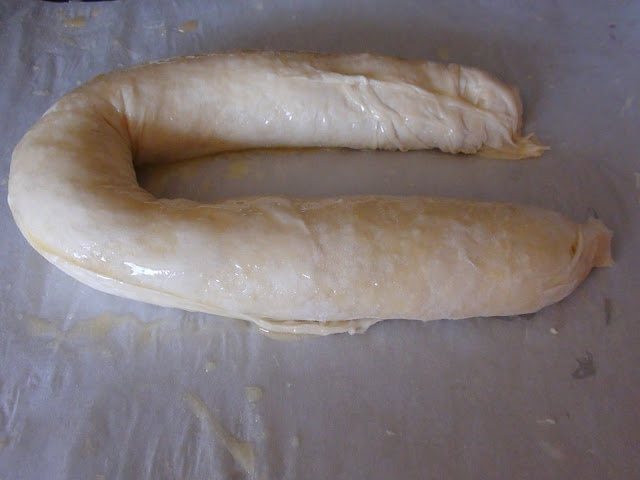
The filling is simple enough. I have no camera person and not being tech savvy, I have yet to document every step of pulling the dough. I seem to get to a crucial stage, get overexcited by the magic of it and promptly forget the camera . By the time I remember the strudel is rolled up. So check out the video, it will help to piece the process together. The lady in the video, scroll down] is making a cherry strudel. She scatters breadcrumbs over the pulled dough, omit this step for cabbage filling.
I made a sweet cabbage strudel, but some people prefer it savory. In such case omit the grated peel and in its place add some freshly grated black pepper. Still, add about a teaspoon of sugar to the filling.
- Make the pulled strudel dough first.
- Place the flours and the salt in a bowl of a standing beater.
- With the whisk attachment, start beating the flours just under medium. Continue beating at this speed. Don’t stop the beater even while you are gathering the rest of the ingredients.
- Add the soft butter and continue beating.
- Add the egg, the vinegar and the lukewarm water and continue beating.
- When the dough comes together, take off the whisk attachment and put on the dough hook.
- Continue beating just below medium speed for 10 to12 minutes.
- Take out the dough, it will be sticky, and place it on a floured board.
- You don’t want folds and air pockets, so knead the dough gently until it no longer sticks to the board.
- Form the dough into a mound.
- Lightly butter the top and cover it with a clean kitchen towel.
- Let the dough rest for a full two hours.
- Meanwhile prepare the filling.
- Place the shredded green cabbage in a large bowl with 2-3 pinches of salt and let it stand for 20 minutes. Squeeze out all he water and discard.
- Place the goose fat or in this case the light olive oil and sweet butter in a large skillet on LOW medium heat.
- Add the cabbage and slowly sauté until tender.
- When the cabbage begins to soften, add the sugar, the grated peel of a whole lemon and the caraway seeds.
- Place a clean white tablecloth or an old sheet on the kitchen table. Don’t use your good linen, because it will stain from the butter.
- Scatter some flour all over the tablecloth and spread it around with your hands.
- Pick up the dough and stretch it a bit with the back of your hand to every direction.
- Place the dough on the center of the cloth.
- Pat it gently to flatten it slightly.
- Now reach under the dough with the backs of your hands against the dough and gently pull your hands apart slightly and toward you, stretching the dough as you do so.
- Work your way around the table repeating this process.
- Stretch the dough further by grasping the outer part of a thick edge and gently tugging on it.
- When the dough has been stretched a few inches more on all sides, repeat the hand movements described above.
- In a few minutes of stretching, a paper thin dough will have reached the edges of the table so you will have a few inches of overhanging dough on every side.
- Rip off the thick edges by hand. Don't use scissors.
- If the dough tears at any point, just leave it alone. If you try to patch it first of all it won't work and secondly it will harden the dough. Any tears will be covered up when the strudel is rolled.
- Use a pastry brush to drizzle the dough with melted butter. Do not let the brush touch the dough and be generous with the butter.
- Turn on the oven to 450 F.
- Arrange the filling in a haphazard log three inches from the edge.
- Using the tablecloth flip the dough over the filling and drip some melted butter on the top.
- Now slowly lift the tablecloth and let the dough slowly roll over the filling. My dough was not a perfect rectangle with lots of tears and I ended up with a fair amount of dough scraps. But that’s OK, nobody will know it in the end.
- Roll over all the dough, cut the extra ends and tuck the ends under.
- Place the strudel on a parchment lined baking sheet and shape the strudel to fit the pan.
- Brush generously with melted butter.
- Bake in the preheated oven at 450 F for 15 minutes.
- Then lower the temperature to 350 F and bake for further 20 minutes or until golden.
- Let the strudel cool to lukewarm and cut into slices
- Cover up leftovers with a clean kitchen towel and store on the counter or in the cupboard. It will keep for a couple of days. However strudel is best on the day it is made







